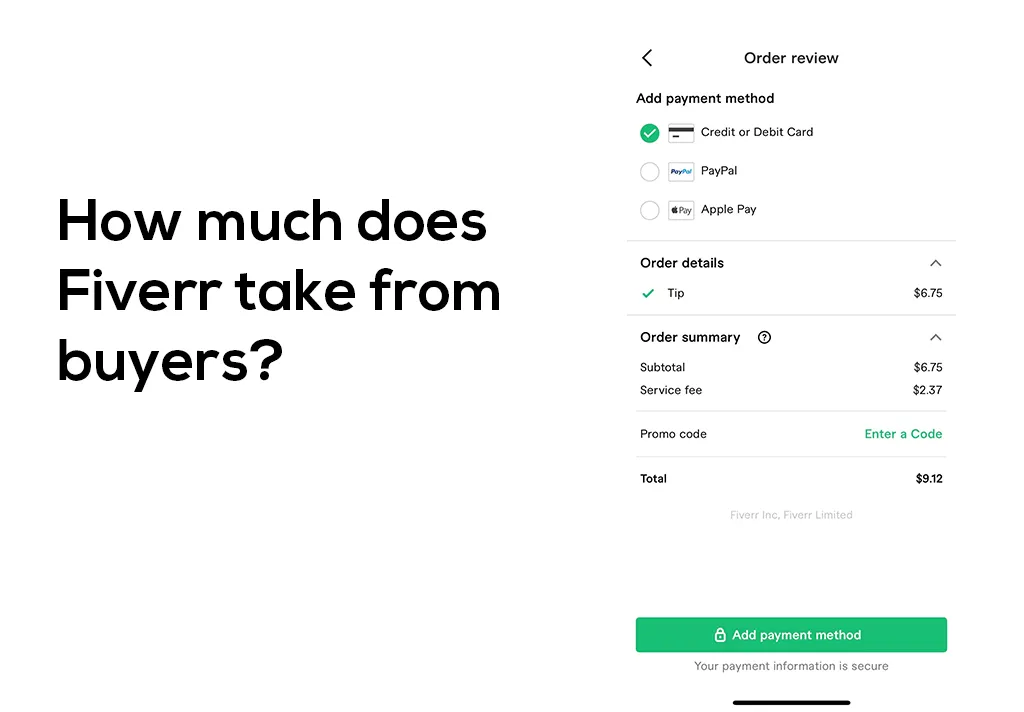When you venture into the world of freelancing, platforms like Fiverr can be incredibly appealing. They provide an opportunity to showcase your skills, reach global clients, and earn some serious cash. But here’s a burning question on many minds: does Fiverr take out a chunk of your hard-earned money? It’s crucial to grasp how Fiverr operates, especially concerning its fees. In this article, we’ll break down the fee structure so you can understand exactly what you’re paying and how it impacts your earnings.
Understanding Fiverr's Fee Structure

Fiverr operates on a clear and straightforward fee structure designed to accommodate both freelancers and clients. But what does that mean for your wallet? Let’s dive into the details!
Initially, Fiverr charges a commission on your earnings, which can be broken down as follows:
- Freelancer Fees: Fiverr typically takes a 20% commission on the total amount you earn from each completed order. For example, if you charge $100 for a service, you’ll receive $80 after the commission is deducted.
- Client Fees: On the buyer’s side, Fiverr adds a service fee that varies based on the total order amount. It's typically a $2 fee for orders up to $40, and a 5% fee for all orders over that amount.
Now, let’s break this down a bit more:
| Order Amount | Fiverr's Cut | You Earn |
|---|---|---|
| $100 | $20 (20%) | $80 |
| $200 | $40 (20%) | $160 |
| $50 | $10 (20%) | $40 |
In addition to these basic fees, additional charges may apply based on payment method or currency conversion fees, depending on where you and your clients are located. Hence, it’s wise to read the fine print associated with those transactions.
Understanding Fiverr’s fee structure helps you set your prices more strategically and manage your financial expectations effectively. With a little planning, you can maximize your earnings while still offering great value to your clients!
Also Read This: How to Become a Fiverr Pro: A Comprehensive Guide
Withdrawal Options and Associated Costs

When it comes to cashing out your hard-earned money from Fiverr, you’ve got several withdrawal options to choose from. Each method has its own associated costs, which is vital to understand before making any decisions. Here’s a breakdown:
- PayPal: This is one of the most popular methods. You can transfer your Fiverr earnings directly to your PayPal account. While receiving payments is free, be aware that withdrawing funds from PayPal to your bank may incur fees, especially for currency conversion.
- Bank Transfer: Fiverr offers a direct deposit option through a bank transfer. This is usually straightforward and doesn’t involve third-party services. However, you might face a small fee depending on your bank. Over time, these fees can add up!
- Fiverr Revenue Card (Payoneer): A great choice for those who wish to have quick access to their funds. The Fiverr Revenue Card allows instant withdrawals, but there may be transaction fees associated with loading the card or when using it internationally.
- Wire Transfer: For larger sums, wire transfers are an option, but they can be costly, often ranging from $15 to $40 depending on your bank's policies.
It's essential to choose the method that aligns with your budget and needs. Always check Fiverr’s [official payment documentation](https://www.fiverr.com) for the most updated information regarding withdrawal options and costs!
Also Read This: Is Fiverr a Crowdsourcing Platform?
Common Misconceptions About Fiverr's Payments
Fiverr is a fantastic platform for freelancers, but with that popularity come a few misconceptions about how its payment system operates. Let's clear up some of the most common misunderstandings:
- Fiverr Takes a Huge Cut: While Fiverr does take a service fee (20% from each transaction), many mistakenly believe it’s significantly higher. A 20% fee is common in freelancing platforms, making it fairly standard in the industry.
- Payments Are Instant: Another prevalent myth is that once you finish a gig, you can immediately withdraw your funds. However, Fiverr has a 14-day waiting period for cleared payments to protect buyers and ensure satisfaction.
- You Can't Ask for Higher Rates: Some users think Fiverr doesn’t allow for higher pricing structures. Contrary to that belief, freelancers can set their prices freely based on their expertise and demand!
- Fiverr’s Fees Are Hidden: Transparency is one of Fiverr’s strong points. All fees are clearly outlined on the platform, so there shouldn’t be surprises when you get your payout.
By understanding these facts, freelancers can navigate Fiverr’s payment system with confidence. To get the best experience on the platform, staying informed is key!
Also Read This: Do You Need a PayPal for Fiverr?
5. How to Minimize Fees on Fiverr
If you're a freelancer or a buyer on Fiverr, you might be curious about how to keep the fees to a minimum. Let's face it, nobody likes to see money slip away in service charges. Fortunately, there are several strategies you can use to reduce the fees on Fiverr without compromising on quality or service. Here are some tips:
- Optimize Your Gigs: As a seller, make sure your gigs are well-optimized. Use relevant keywords, compelling descriptions, and high-quality images to attract more clients. Higher visibility may lead to more orders, which can offset any fees.
- Use Package Deals: If you offer multiple services, consider creating package deals. By bundling services, you can increase your price point and save on per-gig fee percentages.
- Frequent Promotions: Keep an eye on seasonal promotions or Fiverr events. Participating in these can sometimes reduce the fees or provide other financial benefits.
- Communicate with Clients: Encourage clients to tip you through the platform. Tips are typically not subject to the same fee percentages, meaning you take home more of that additional income.
- Maintain Good Ratings: A solid rating can lead to more orders. More orders may allow you to focus on quality over quantity, which can be more lucrative in the long run.
By implementing these strategies, you can minimize fees and maximize your profits on Fiverr. A little diligence can go a long way!
Also Read This: Can You Turn Down Projects on Fiverr?
6. Alternatives to Fiverr for Freelancing
While Fiverr has become a well-known marketplace for freelancers, it’s not the only option out there. In fact, depending on your skills or needs, you might find that other platforms better suit your style. Here’s a look at some great alternatives to Fiverr:
| Platform | Best For | Key Features |
|---|---|---|
| Upwork | Freelancers and businesses looking for long-term contracts | Flexible payment options, a wide range of categories, and robust client communication tools. |
| Freelancer.com | Competitive bidding on projects | Large user base with diverse job postings and contests for project bids. |
| 99designs | Graphic designers | Focus solely on design work, with options for contests and direct projects. |
| PeoplePerHour | Short-term projects | Hourly pricing options and a user-friendly interface for quick project fulfillment. |
| Toptal | High-skilled professionals | Focus on top freelancers only, with rigorous vetting to curate talent. |
Each of these platforms has its unique features and specialties, so take the time to explore what might work best for you. Whether you’re a buyer looking for quality talent or a freelancer seeking new opportunities, there’s an alternative to Fiverr ready to meet your needs!
Does Fiverr Take Out Your Money?
Fiverr is a popular online marketplace that connects freelancers with clients looking for various services, ranging from graphic design to digital marketing. Many users often wonder whether Fiverr takes out their money and how the financial aspects of transacting on the platform work. In this article, we'll explore the fee structure and payment procedures to shed light on the question: does Fiverr take out your money?
Understanding Fiverr's Fee Structure
Fiverr operates on a commission-based model, which means that it takes a percentage of each transaction between freelancers and clients. Here’s a breakdown of how the fees work:
- Service Fees: Fiverr charges freelancers a 20% commission on each sale. This means that if a freelancer completes a job for $100, they will receive $80 after Fiverr's cut.
- Buyer Fees: Clients may also incur a service fee when purchasing a gig, typically ranging from $2 to $40, depending on the order value.
How Payments are Processed
When you place an order on Fiverr, the payment is processed immediately. However, the funds are held in escrow until the freelancer completes the work. Here's how the process unfolds:
| Step | Description |
|---|---|
| 1. Order Placement | Client pays upfront, and Fiverr holds the funds. |
| 2. Order Completion | Freelancer submits the work for review. |
| 3. Payment Release | Funds are released to the freelancer after approval. |
In conclusion, Fiverr does take a portion of the payments processed on its platform, with fees applied to both freelancers and clients. While Fiverr holds the funds initially, they ensure a secure transaction process to protect both parties involved in the exchange.



